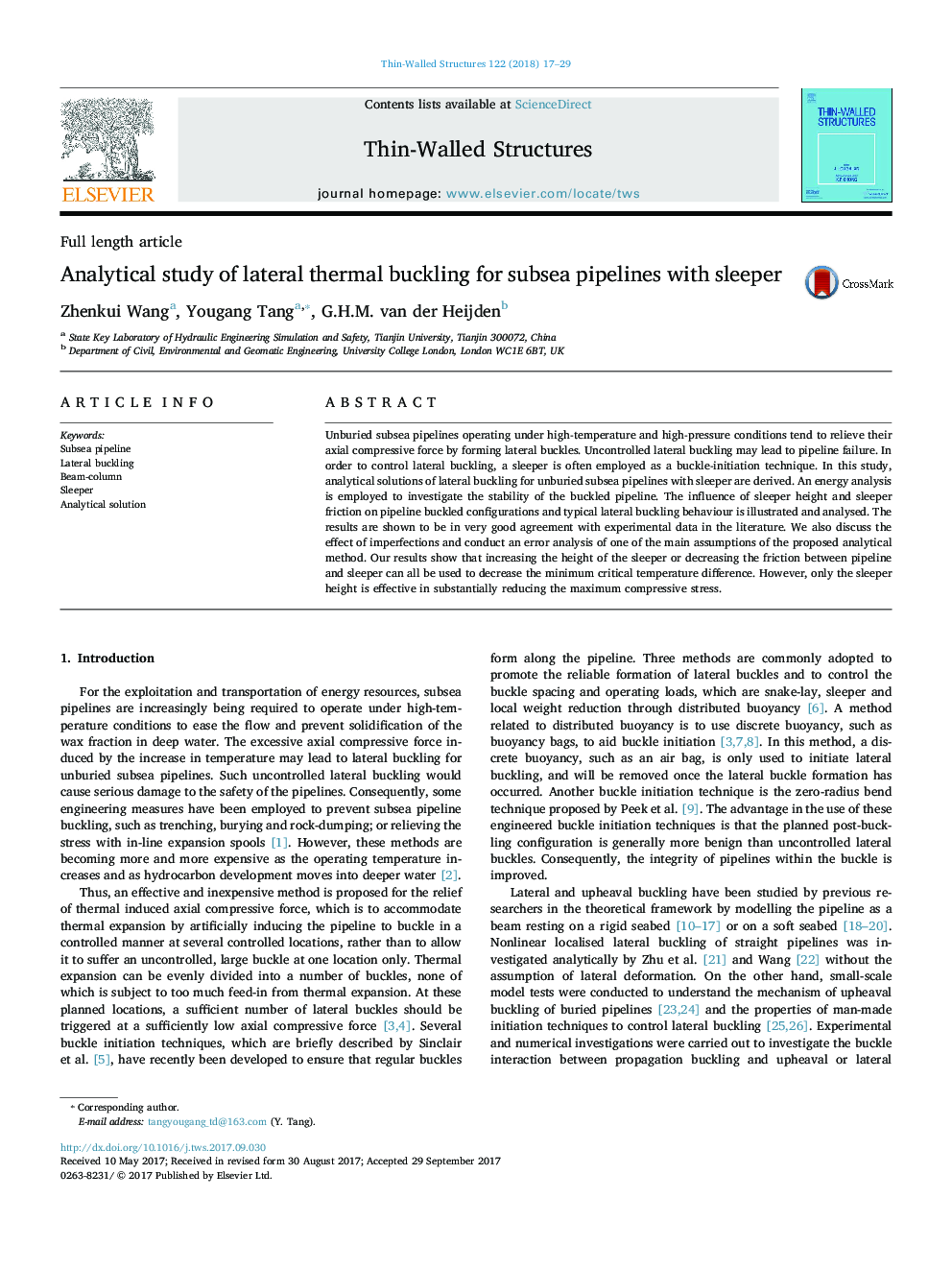| کد مقاله | کد نشریه | سال انتشار | مقاله انگلیسی | نسخه تمام متن |
|---|---|---|---|---|
| 4928331 | 1432069 | 2018 | 13 صفحه PDF | دانلود رایگان |
عنوان انگلیسی مقاله ISI
Analytical study of lateral thermal buckling for subsea pipelines with sleeper
ترجمه فارسی عنوان
مطالعه تحلیلی از خم شدن حرارتی جانبی برای لوله های زیرزمینی با خواب
دانلود مقاله + سفارش ترجمه
دانلود مقاله ISI انگلیسی
رایگان برای ایرانیان
کلمات کلیدی
خط لوله زیرین، لرزش جانبی، ستون پرتو، خواب راه حل تحلیلی،
ترجمه چکیده
خطوط زیر دریایی بیرونی که تحت شرایط با درجه حرارت بالا و فشار بالا عمل می کنند، باعث ایجاد نیروی فشاری محوری می شوند. لرزش جانبی کنترل نشده ممکن است منجر به شکست خط لوله شود. به منظور کنترل لرزش جانبی، یک خواب به عنوان یک روش آغاز کننده دست و پنجه نرم استفاده می شود. در این تحقیق، راه حل های تحلیلی بوسیله لبه های جانبی برای لوله های زیرزمینی بیرونی با خواب جای گرفته است. تجزیه و تحلیل انرژی مورد استفاده قرار گرفته است برای بررسی پایداری خط لوله باکله. تأثیر ارتفاع اصطکاک خواب و اصطکاک خواب در تنظیمات خطی خطوط و رفتار معمولی خمشی نشان داده شده و مورد تجزیه و تحلیل قرار گرفته است. نتایج نشان می دهد که با داده های تجربی در ادبیات، توافق بسیار خوبی دارد. ما همچنین درباره اثر ناهنجاری ها بحث می کنیم و یک تحلیل خطا از یکی از مفروضات اصلی روش تحلیلی پیشنهاد شده را انجام می دهیم. نتایج ما نشان می دهد که افزایش ارتفاع خواب یا کاهش اصطکاک بین خط لوله و خوابگاه می تواند برای کاهش حداقل اختلاف دمای بحرانی استفاده شود. با این حال، تنها ارتفاع خواب در کاهش قابل ملاحظه حداکثر استرس فشاری موثر است.
موضوعات مرتبط
مهندسی و علوم پایه
سایر رشته های مهندسی
مهندسی عمران و سازه
چکیده انگلیسی
Unburied subsea pipelines operating under high-temperature and high-pressure conditions tend to relieve their axial compressive force by forming lateral buckles. Uncontrolled lateral buckling may lead to pipeline failure. In order to control lateral buckling, a sleeper is often employed as a buckle-initiation technique. In this study, analytical solutions of lateral buckling for unburied subsea pipelines with sleeper are derived. An energy analysis is employed to investigate the stability of the buckled pipeline. The influence of sleeper height and sleeper friction on pipeline buckled configurations and typical lateral buckling behaviour is illustrated and analysed. The results are shown to be in very good agreement with experimental data in the literature. We also discuss the effect of imperfections and conduct an error analysis of one of the main assumptions of the proposed analytical method. Our results show that increasing the height of the sleeper or decreasing the friction between pipeline and sleeper can all be used to decrease the minimum critical temperature difference. However, only the sleeper height is effective in substantially reducing the maximum compressive stress.
ناشر
Database: Elsevier - ScienceDirect (ساینس دایرکت)
Journal: Thin-Walled Structures - Volume 122, January 2018, Pages 17-29
Journal: Thin-Walled Structures - Volume 122, January 2018, Pages 17-29
نویسندگان
Zhenkui Wang, Yougang Tang, G.H.M. van der Heijden,
